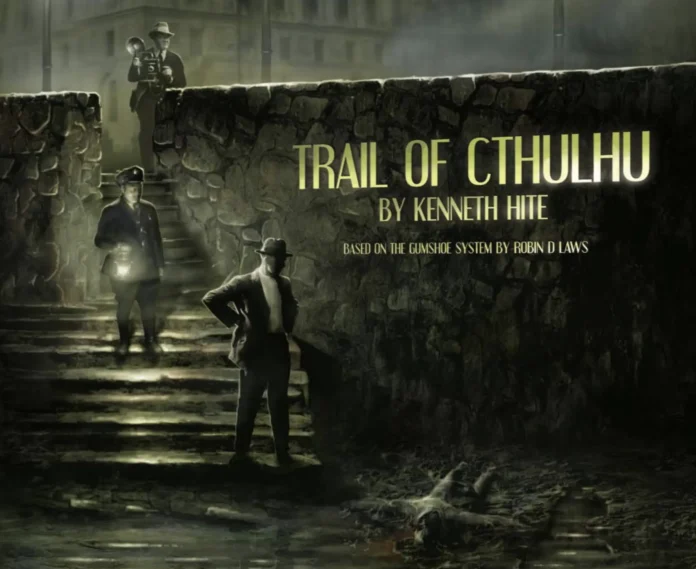In our growing list of games to mention for the spooky season, Trail of Cthulhu is one of my preferred genres, cosmic horror.
Trail of Cthulhu was designed by (amongst others) Kenneth Hite and Robin Laws, and uses the GUMSHOE system, which was developed by Laws in 2007. The central conceit of the GUMSHOE system is that the players of investigative scenarios and stories shouldn’t have to roll dice to actually get their hands of clues, they should just get them for being at the right time and place with the right skills.
For Trail of Cthulhu, this is specifically mentioned as fixing an issue with Call of Cthulhu scenarios whereby a single failed roll to pick up a clue can bring the story to a grinding halt. The central maxim behind Trail of Cthulhu is that “Investigative scenarios are not about finding clues. They are about interpreting the clues you do find”.
The book is well structured, though utilises a three column text layout that I personally find less readable than the two column layout employed in something like Delta Green’s product line.
Mechanically, Trail is structured around pools of points in an array of abilities the character has, broken down into General Abilities and Investigative Abilities, which are themselves broken down into Academic, Interpersonal, and Technical skills. As a rule, simply having points in an Investigative Ability is enough to gain a clue associated with it, though characters can spend additional points from a recoverable pool, which will allow additional information that could be helpful for an investigator to be gleaned.
General Abilities cover, predictably enough, more general traits, such as Health, Sanity, Stability (a distinction we’ll get to later), First Aid, and the system’s combat skills.
In those instances where the outcome of the use of an ability is in doubt, such as combat and various associated checks, every test in this system is resolved as a d6 check, plus any points from the relevant skill’s pool the player wishes to spend, and tries to exceed a difficulty number, typically ranging from 2-8 where 2 is a trivial task and 8 is nearly impossible. Point spends must be declared prior to the roll.
It’s in this section of the book that breaks down the mechanics that has many examples of one of Trail’s nicest features; rules for Purist mode and rules for Pulp mode. Purist games are more lethal, the characters more limited in their prowess, and Pulp games tend to feature larger than life, very capable characters, with larger pools of skills, and higher maximals on their Health and Sanity as an option. One such option that distinguishes a Pulp and Purist game is whether or not the Keeper (the nomenclature carried from Call of Cthulhu… for now, at least, more on that later) declares the Difficulty Number of a roll before or after the player rolls.
The system being designed around these point spends allows flexibility for characters working in collaboration, with two characters freely contributing as many points as they want from a relevant skill pool, all but one of which count towards the check.
Combat is, admittedly, not necessarily the strongest aspect of this system. It boils down to Scuffling (unarmed) vs Scuffling, Scuffling vs Weapons (melee implements), or Weapons vs Weapons for close quarters combat, and Firearms vs Firearms. Attacks are made against a target’s Hit Threshold, which will be either 3 or 4 for characters with high Athletics, or even 4 or higher for Mythos entities, potentially. Damage is resolved as a damage roll (the usual d6) plus the lethality range of the weapon, which ranges; -2 for unarmed strikes, 0 for things like machetes, +1 for swords or heavy firearms. Firearms do additional damage at close range.
There are some rules for cover, which adds to a character’s Hit Threshold.
Final damage is then deducted from the victim’s Health pool. Armour is ablative, reducing incoming damage at a flat rate (1 point of armour for a thick leather coat, for instance). Death doesn’t occur at 0 Health; at 0 to -5, a character is Hurt, and increases the Difficulty of all checks by 1. At -6 to -11, a character is Seriously Wounded, and is no longer able to fight, continuing to lose Health periodically until dead or receiving First Aid. At -12 a character dies.
Finally, there are rules for different forms of harm, like temperature extremes, suffocation, falling, fire, and poison. Later GUMSHOE games have added a lot more nuance and options to combat that vastly improve it by comparison to Trail, and of course it’s worth asking; how much detailed combat rules do you really need in what’s largely meant to be a horror game, anyway?
The next section of the book is one of the most important, covering Sanity, Stability, and Madness. One of the central conceits of Trail is the distinction between Sanity and Stability; Sanity is the integrity of the mind in the face of the terrible reality of the Mythos, while Stability represents resilience in the face of more mundane threats like violence (though supernatural entities can make a character lose both).
Trail is clear that it wants to make this distinction to hew closer to the tone and pace of Lovecraft’s fiction, a claim that has some justification, directly citing Dr Armitage from The Dunwich Horror, a character who’s read through the Necronomicon repeatedly and seems to be stable and function; using just Sanity like Call of Cthulhu and Delta Green do should probably leave a character severely affected, if not a gibbering wreck if a character in those systems tried similar. However, those who have run both of these games point out there are ways to justify this. While I do like the idea of Sanity and Stability, I’m not sure how much gain there is in bringing the distinction to the table in play. Ultimately it’s going to be a question of preference for how much you think it adds. Personally I’d favour adapting to certain forms of trauma as Delta Green handles it.
That said, getting players to engage with the horror is something Trail has a nice knack for; as part of character creation, characters choose a Drive, which includes things like Arrogance, Artistic Sensitivity, Curiosity, Duty, Ennui, and similar. These Drives are what compel a character to keep interacting with the Mythos, rather than retiring and trying to forget all about it. The Keeper can directly leverage a character’s Drive in the attempt to get them looking into something, their Drive compelling them to potentially irrational action in their investigation. Characters can choose to ignore this call, though it comes with a cost. The Keeper can impel what are called hard and soft drivers, the former designed to directly forward the main plot, the latter of which is more suited to common sense when it feels like a character’s Drive should be relevant, both of which can be resisted at the cost of Stability, or embraced to gain Stability… though will likely lead to horrible encounters to chip away at it again. From that perspective, having Duty create what’s essentially an ablative layer between choice and consequence is actually really smart game design for the horror genre. Some people might object to the potential loss of agency, but I’d say this is actually quite lenient for a horror game, giving quite a lot of choice, and if you can’t accept the occasional lack of agency in a horror game then you’re likely barking up the wrong genre. There are interesting actions between loss of Sanity and the beliefs which underpin a character’s personality, chosen during character creation, called Pillars of Sanity. These include such things as a specific deeply held religious faith, a belief in the innate goodness of humanity, duty and honour, love of one’s home, and so on, which can wither and crumble in response to substantial enough Sanity loss, as a roleplaying consequence, though how permanent this loss of belief is varies between Purist and Pulp games. A character who loses all their Pillars of Sanity is said to be acting purely out of survival instinct, and finds Stability tests more difficult in future. In another very smart design choice that sings of ludonarrative harmony, a character exposed to debilitating Sanity loss can instead choose to pass out rather than fully absorb the experience, reducing their Sanity loss to 1 instead, very reminiscent of a Lovecraft short story. Which is, of course, by design, called out by a sidebar in this section of the book, talking about the moment of the “big reveal” and how pivotal it is the climax of a story, at least in a Purist scenario, enhancing the level of Sanity loss to ridiculous heights basically guaranteeing a dark ending. Not at all a bad thing, though likely suited to one shots, or shorter campaign arcs where longevity of the characters isn’t necessarily a factor in story coherence.
No cosmic horror game would be complete without a section on mental illness — or, rather, the view of mental illness through the lens of Lovecraft — with rules for various manias and madnesses and the different ways they make the character interact with the world. I particularly like the Obsession madness, which requires the character to take 4 points from any of their abilities which can then only be used in the presence of their obsession, there’s an elegance to it.
Following this are general downtime rules, going over recovery of points pools, Health, Stability during downtime between adventures, and a distinction between Pulp and Purist games for the viability of Sanity recovery; naturally this loss is an inevitable downward spiral for the poor, unfortunate Purist investigator. Found here are also rules for improving investigators, typical build points for a 3-4 hour sessions, the cost to improve abilities and similar, including the particularly harsh Purist option to allow no improvement for characters at all.
What follows is, to my mind, the best section of the book, and a reason to pick it up even if you had no intention of running Trail; The Cthulhu Mythos. The uniqueness and quality of the writing is at its peak here, going over figures in the Mythos known and less well known, offering — and this is the crucial point — wildly different takes on each entity. As an example, Nyarlathotep is given the widely known interpretation of being the messenger of the outer gods, but is also offered as being the “interphase state between between human perception and the Mythos, like a film of water on soap”, which is just a fantastic idea. Each of the gods and entities is given five or six fairly different interpretations and ideas like this, and it’s an absolute gold mine for fresh ideas and reinventing some stale concepts. I might honestly recommend this book on the basis of this alone, the writing absolutely sings in this section.
Following this is how Mythos Tomes function, rules for how long it takes to read them, and how they increase Cthulhu Mythos. There’s a list of toms, some famous like Al Azif, which have some unique rules per tome, such as the Seven Cryptical Books of Hsan giving dedicated bonus point spends to checks involving China or dreams, which is an effective way to flavour them in a way that prevents them just being a list of names with associated Sanity loss and Mythos gain, something that it occasionally ends up being in Call of Cthulhu. Rules for magic and spells are present, though arguably a bit undercooked. They’re very serviceable, and have good ideas about certain magic working only under certain circumstances and places for a bit of variety, and to the book’s credit the flavour text for each spell is very decent.
There’s a bestiary section with some phenomenal writing on details gleaned by using certain skills to investigate entities, such as using Forensics to get a vivid description of what the victim of a Deep One attack looks like, with vicious slash wounds. As with the section on gods and titans, this is a phenomenally written bestiary that’s worth mining for ideas irrespective of whether you use this game to run cosmic horror or not, followed by a similarly well written section on various cults and plot hooks on how you can work them into a broader story.
There’s a primer on the 1930s — the ostensible era that Trail is set in — that’s useful for historical context, and for utilising facts of the era to forward the tone of the game. Not strictly necessary, arguably, but certainly helpful.
The equipment and weapons section is comprehensive, and includes common costs of items during that time. Not much to say here, but it’s fit for purpose, not to damn it with faint praise.
The advice and guidance section for Keepers is useful both from the perspective of running cosmic horror games, and how to structure and pace GUMSHOE games vis a vis point spends, clue use and scenario structure, etc. Better than serviceable, this section is comprehensive and useful for both a newcomer and an old hand to running games.
Mindful that this review has rambled on too long already, I’ll briefly mention the Campaign Frames, which are ideas for structuring the broad outline of a campaign — circumstances and events that give reasons for the investigators to come together and work in common purpose — that are a great way to get started with a game.
A scenario, the Kingsbury Horror, rounds out the back of the book, and again touching briefly on it is a good intro to the precepts and ideas behind running Trail games, it’s worth running, though there’s also a very good one shot available for purchase called The Dance In The Blood, written by the incomparable Graham Walmsley, author of Stealing Cthulhu. Perhaps that’ll be a review for another day.
To summarise, Trail of Cthulhu is an excellent game, even if I’m not completely in love with the mechanics, simply because it’s tone and grasp of cosmic horror and the Cthulhu Mythos is phenomenal, often reaching the tone of horror and despair in a way Call of Cthulhu sometimes misses (though Delta Green does not). A game that knows its tone and genre inside out.
And worth mentioning, at time of publication, Pelgrane Press are actively working on a fully backwards compatible second edition of the game, and have released a demo of the Quickstart guide on backerkit (available for free to check out here). I’m immensely relieved to see they’re using a two column layout rather than the three column layout they employed over 1st edition’s lifespan, which was my only major issue with the layout of Pelgrane’s otherwise phenomenal products.
Available for purchase at DriveThruRPG for about $24.99.
Help keep news FREE for our readers
Supporting your local community newspaper/online news outlet is crucial now more than ever. If you believe in independent journalism, then consider making a valuable contribution by making a one-time or monthly donation. We operate in rural areas where providing unbiased news can be challenging. Read More About Supporting The West Wales Chronicle























